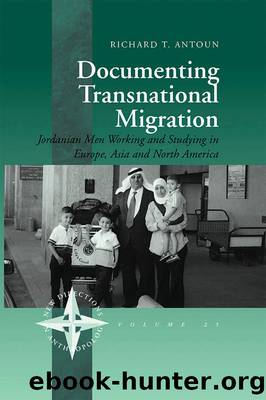Documenting Transnational Migration by Richard T. Antoun†

Author:Richard T. Antoun† [Antoun†, Richard T.]
Language: eng
Format: epub
Tags: Social Science, Emigration & Immigration, Anthropology, Cultural & Social, Law
ISBN: 9780857455376
Google: dCJpw5EO3r4C
Publisher: Berghahn Books
Published: 2005-07-01T04:21:51+00:00
Notes
1. See the essays devoted to Pakistan by Binder, Cohen, Esposito, and Harrison in Ali Banuazizi and Marvin Weiner, editors, The State, Religion, and Ethnic Politics: Afghanistan, Iran, and Pakistan, Syracuse University Press, 1986, for a discussion of the importance of religion and language in the development of modern Pakistan.
2. The only two students who lived off the campus about whom I have information were Six and Nine. Nine was forced off the campus in Peshawar when the university closed following a prolonged strike. Six roomed off the campus with a Palestinian for a year, and then returned to the campus for his final two years.
3. The accounts by migrant students of dating Pakistani undergraduates must be viewed skeptically. Undergraduate women usually went to separate womenâs colleges. At Faisalabad and Peshawar universities there were very few female students. Personal communication, Iftikhar Ahmed.
4. Many never acclimatized, complaining of the intense heat, though at the same time they loved the rivers, the valleys, and the verdant fields. Some complained of being sick, and one, at least, had malaria.
5. There are exceptions to most of these generalizations, e.g., Four said he loved Pakistani food and Ten mixed with Pakistani students, studied with them, and in his appraisal called them âlovely boys.â
6. The examination system in Pakistan varies from university to university. Some universities still follow the semester system whereas others have changed to annual examinations (the British system). The semester system was introduced in universities during the early â70s, but it didnât work in many universities for a variety of reasons: inadequate experience with the system; deficiency in human and financial resources; and lack of commitment to the system. Therefore many universities returned to the annual exam system after a few years of experimenting with the semester system.
7. Not only status but caste differences. Pakistan has castes in many parts of the country in the sense of rigidly separate, hierarchically ordered sets of localized social groups. Occupations are ranked and groups often interact according to a nonmonetary set of reciprocal social services that reflect that ranking. But the castes of Pakistan are not like Indian castes in that they lack the ritual and symbolic system based on the concept of purity that orders and compares the ranked groups in a homologous fashion. In the Punjab the emphasis is more on the clan or biraderi system, the latter being the smallest endogamous group representing the meaningful unit for marriage ties and dispute settlement.
8. This laissez-faire policy is similar to that of universities in the United States which make no effort to teach incoming foreign students English, although they do provide remedial instruction.
9. Urdu is understood and spoken in all Pakistani cities and towns and is the native language of many of the muhajirs who lived in India before the partition of Indian and Pakistan in 1947. But it is not spoken or understood in many rural areas of the country.
10. See the essays by Leonard Binder and Selig Harrison in Ali Banuazizi and Myron
Download
This site does not store any files on its server. We only index and link to content provided by other sites. Please contact the content providers to delete copyright contents if any and email us, we'll remove relevant links or contents immediately.
Killers of the Flower Moon by David Grann(3761)
Machine Learning at Scale with H2O by Gregory Keys | David Whiting(3660)
Oathbringer (The Stormlight Archive, Book 3) by Brandon Sanderson(2657)
Will by Will Smith(2593)
Once Upon a Broken Heart by Stephanie Garber(2537)
Guns, Germs and Steel by Diamond Jared(2206)
Borders by unknow(2122)
It Starts With Us (It Ends with Us #2) by Colleen Hoover(2058)
The Room Where It Happened by John Bolton;(2036)
Friends, Lovers, and the Big Terrible Thing by Matthew Perry(2018)
The Color of Law by Richard Rothstein(1824)
HBR's 10 Must Reads 2022 by Harvard Business Review(1703)
The Strength In Our Scars by Bianca Sparacino(1702)
A Short History of War by Jeremy Black(1679)
Water Rights and the Environment in the United States by John Burch(1607)
Examples & Explanations: Administrative Law by William F. Funk & Richard H. Seamon(1555)
515945210 by Unknown(1525)
Pharmacy Practice and The Law by Richard Abood(1497)
That Every Man Be Armed by Stephen P. Halbrook(1481)
